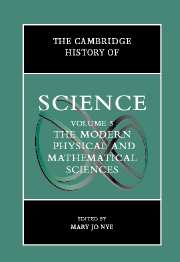Book contents
- Frontmatter
- Introduction: The Modern Physical and Mathematical Sciences
- Part I The Public Cultures of the Physical Sciences After 1800
- Part II Discipline Building in the Sciences: Places, Instruments, Communication
- Part III Chemistry and Physics: Problems Through the Early 1900s
- Part IV Atomic and Molecular Sciences in the Twentieth Century
- 17 Quantum Theory and Atomic Structure, 1900–1927
- 18 Radioactiviy and Nuclerar Physics
- 19 Quantum Field Theory: From QED to the Standard Model
- 20 Chemical Physics and Quantum Chemistry in the Twentieth Century
- 21 Plasmas and Solid-State Science
- 22 Macromolecules: Their Structures and Functions
- Part V Mathematics, Astronomy, and Cosmology Since the Eighteenth Century
- Part VI Problems and Promises at the End of the Twentieth Century
- Index
- References
20 - Chemical Physics and Quantum Chemistry in the Twentieth Century
from Part IV - Atomic and Molecular Sciences in the Twentieth Century
Published online by Cambridge University Press: 28 March 2008
- Frontmatter
- Introduction: The Modern Physical and Mathematical Sciences
- Part I The Public Cultures of the Physical Sciences After 1800
- Part II Discipline Building in the Sciences: Places, Instruments, Communication
- Part III Chemistry and Physics: Problems Through the Early 1900s
- Part IV Atomic and Molecular Sciences in the Twentieth Century
- 17 Quantum Theory and Atomic Structure, 1900–1927
- 18 Radioactiviy and Nuclerar Physics
- 19 Quantum Field Theory: From QED to the Standard Model
- 20 Chemical Physics and Quantum Chemistry in the Twentieth Century
- 21 Plasmas and Solid-State Science
- 22 Macromolecules: Their Structures and Functions
- Part V Mathematics, Astronomy, and Cosmology Since the Eighteenth Century
- Part VI Problems and Promises at the End of the Twentieth Century
- Index
- References
Summary
In 1967, Per-Olov Löwdin introduced the new International Journal of Quantum Chemistry in the following manner:
Quantum chemistry deals with the theory of the electronic structure of matter: atoms, molecules, and crystals. It describes this structure in terms of wave patterns, and it uses physical and chemical experience, deep-going mathematical analysis, and high-speed electronic computers to achieve its results. Quantum mechanics has rendered a new conceptual framework for physics and chemistry, and it has led to a unification of the natural sciences which was previously inconceivable; the recent development of molecular biology shows also that the life sciences are now approaching the same basis.
Quantum chemistry is a young field which falls between the historically developed areas of mathematics, physics, chemistry, and biology.
In this chapter I address the emergence and establishment of a scientific discipline that has been called at times quantum chemistry, chemical physics, or theoretical chemistry. Understanding why and how atoms combine to form molecules is an intrinsically chemical problem, but it is also a many-body problem, which is handled by means of the integration of Schrödinger’s equation. The heart of the difficulty is that the equation cannot be integrated exactly for even the simplest of all molecules. Devising semiempirical approximate methods became, therefore, a constitutive feature of quantum chemistry, at least in its formative years.
- Type
- Chapter
- Information
- The Cambridge History of Science , pp. 394 - 412Publisher: Cambridge University PressPrint publication year: 2002
References
- 4
- Cited by



